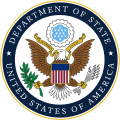The U.S. Department of State's Bureau of International Information Programs (IIP) supported the department's public diplomacy efforts by providing and supporting the places, content, and infrastructure needed for "sustained conversations"[weasel words] with foreign audiences. It was headed by the Coordinator for International Information Programs. IIP was one of three bureaus that reported to the Undersecretary for Public Diplomacy and Public Affairs. The Bureau of Educational and Cultural Affairs and the Bureau of Public Affairs were its sister bureaus. On May 28, 2019, IIP merged with the Bureau of Public Affairs into the Bureau of Global Public Affairs, and the duties of IIP Coordinator merged into the duties of the Assistant Secretary of State for Global Public Affairs.[3]
 Seal of the United States Department of State | |
| Bureau overview | |
|---|---|
| Dissolved | May 28, 2019 |
| Superseding bureau | |
| Jurisdiction | Executive branch of the United States |
| Employees | 458 (As of 2013[update])[1] |
| Annual budget | $55 million[2] |
| Parent department | U.S. Department of State |
| Website | Official Website |
History
editWhen the Foreign Affairs Reform and Restructuring Act of 1998 abolished the United States Information Agency (USIA) on October 1, 1999, USIA's broadcasting functions were moved to the then newly created Broadcasting Board of Governors (BBG), and its non-broadcasting information functions were given to the then newly created Under Secretary of State for Public Diplomacy and Public Affairs. The Bureau of International Information Programs was created as a part of this restructuring.[4]
Mission and purpose
editAccording to the bureau's page on the Department of State website, IIP "provides and supports the places, content, and infrastructure needed for sustained conversations with foreign audiences to build America's reputation abroad".[5]
Physical and virtual places include over 700 American Spaces around the world,[6] as well as a large social media community that numbers over 12 million followers. Content includes publications, video, and U.S. expert speakers, who engage foreign audiences both in person and through virtual programs. An example of this is the Arabic-language Twitter channel @USAbilAraby. IIP managed the infrastructure for all embassy and consulate websites, translations of public remarks by the President and Secretary, and maintains internal websites with resources for use by public diplomacy officers for overseas programs.
Responsibilities
editThis article contains promotional content. (November 2023) |
The Bureau of International Information Programs provided public diplomacy materials and support in three primary areas:
- Digital
IIP operates the department's embassy and consulate websites (http://usembassy.gov) in over 60 languages. IIP also supports embassy social media efforts with Facebook pages and Twitter sites in six languages.
IIP also operates an interactive web-chat platform that links foreign audiences to U.S. subject matter experts, opinion-makers, community leaders, and government officials in more than 800 programs each year. In September 2014, the bureau launched a new social sharing platform ShareAmerica to distribute public diplomacy content.
- American Spaces
American Spaces exemplify the United States commitment to a core tenet of democracy: the citizen's right to free access to information. Hosting more than 16 million visits each year, American Spaces supports public diplomacy by creating a place for in-person engagement with foreign audiences. Over 700 Spaces are hosted in embassies, schools, libraries, and other partner institutions in 169 countries. They provide information about United States' policy, culture, and values as well as study in the United States. They also support English language learning and activities for alumni of international visitor programs.
- Public Diplomacy (PD) Content
IIP creates and curates content that provides context and information on U.S. foreign policy topics in a variety of formats ranging from video to print publications to audiobooks, reaching more than one billion people a year. Much of this content, along with transcripts of the Secretary's and President's speeches, is available to embassies in multiple languages. IIP also produces more than 125 video products each year and recruits more than 650 speakers annually, including Supreme Court justices, renowned authors, innovators, scholars, entrepreneurs, journalists, and sports figures who connect directly with more than 160,000 people in local markets via in-country and virtual events.
- Analytics
IIP has an advanced analytics capacity to measure output, campaign performance, perform audience analysis and track over 2,000 Department of State social media properties.
Leadership
editMacon Phillips served as IIP coordinator from 2013 to 2017.[7]
Sub-agencies
editThe Counter Misinformation Team or Counter Mis-information Team (CMT), headed by Todd Leventhal, was part of the Bureau of International Information Programs. CMT was originally formed to counter Soviet misinformation during the Cold War.[8] and was tasked with responding to alleged misinformation and disinformation about the United States government. It was discontinued at the end of the Bush administration.
In an attempt to debunk 9/11 conspiracy theories, CMT released "The Top September 11 Conspiracy Theories"[9] report on August 28, 2006.[10]
See also
editReferences
edit- ^ "Inspection of the Bureau of International Information Programs" (PDF). Office of the Inspector General of the Department of State. May 2013. Retrieved November 21, 2015.
- ^ "Bureau of International Information Programs". AllGov. Retrieved March 22, 2016.
- ^ "Administrative Timeline of the Department of State". United States Department of State. Retrieved August 25, 2021.
- ^ "H.R. 1757 (ENR) - Foreign Affairs Reform and Restructuring Act of 1998". www.govinfo.gov. Retrieved November 25, 2023.
- ^ "Bureau of International Information Programs". U.S. Department of State.
- ^ "American Spaces". U.S. Department of State.
- ^ "Bureau of International Information Programs". 2009-2017.state.gov. Retrieved October 7, 2023.
- ^ Aistrope, Tim (2016). "Social Media and counterterrorism strategy". Australian Journal of International Affairs. 70 (2): 121–138. doi:10.1080/10357718.2015.1113230. S2CID 156018701.
- ^ "The Top September 11 Conspiracy Theories". Counter Misinformation Team. Archived from the original on February 28, 2011.
- ^ "U.S. moves to debunk 'alternative theories' on September 11 attacks". International Herald Tribune. Archived from the original on October 20, 2006.